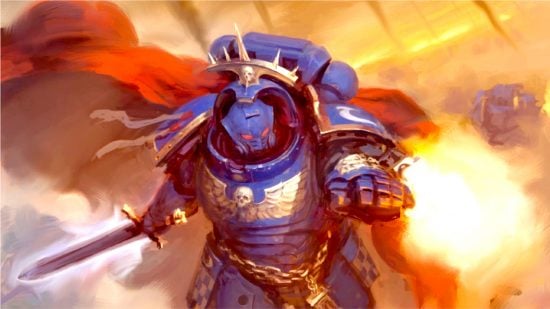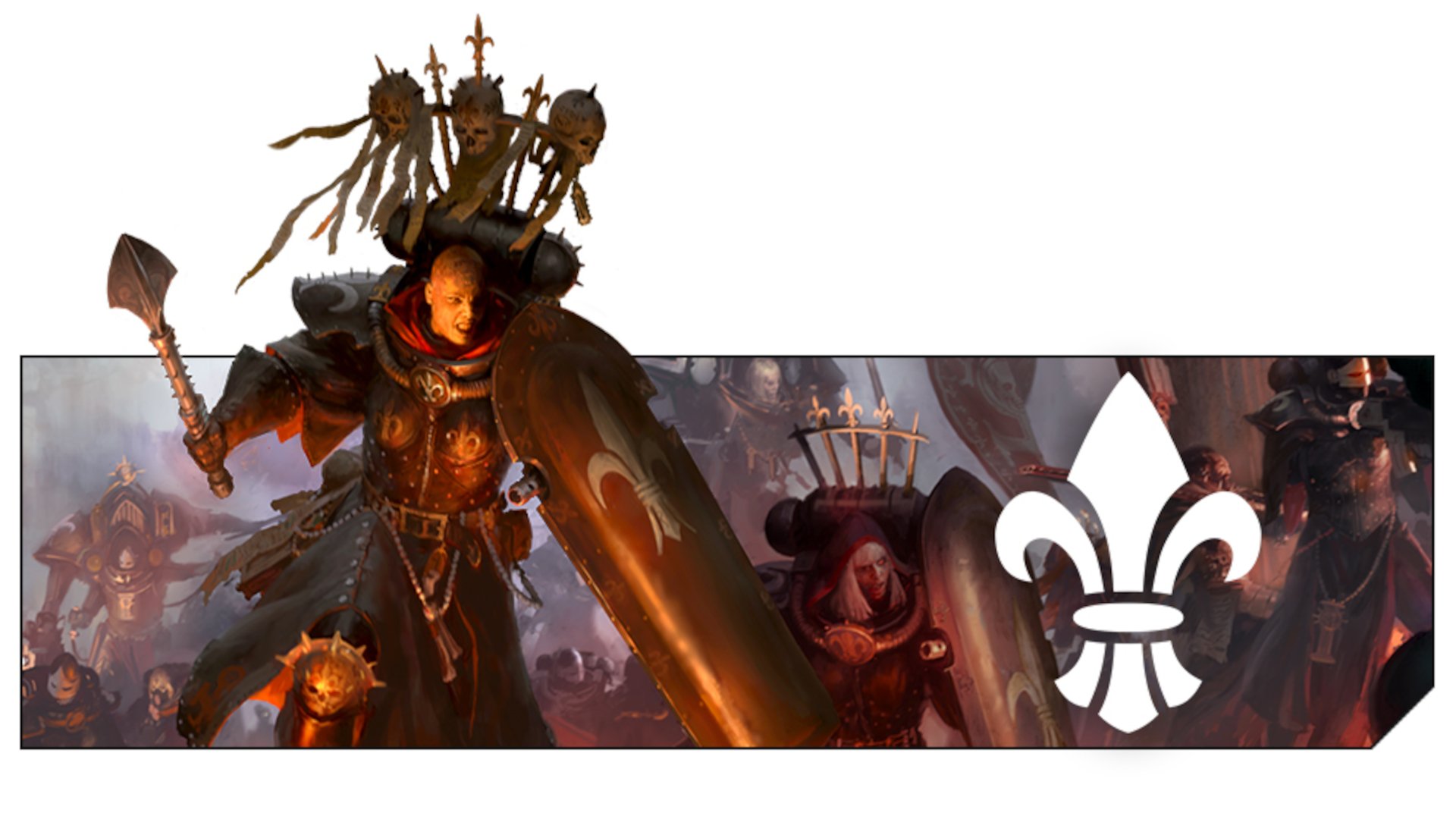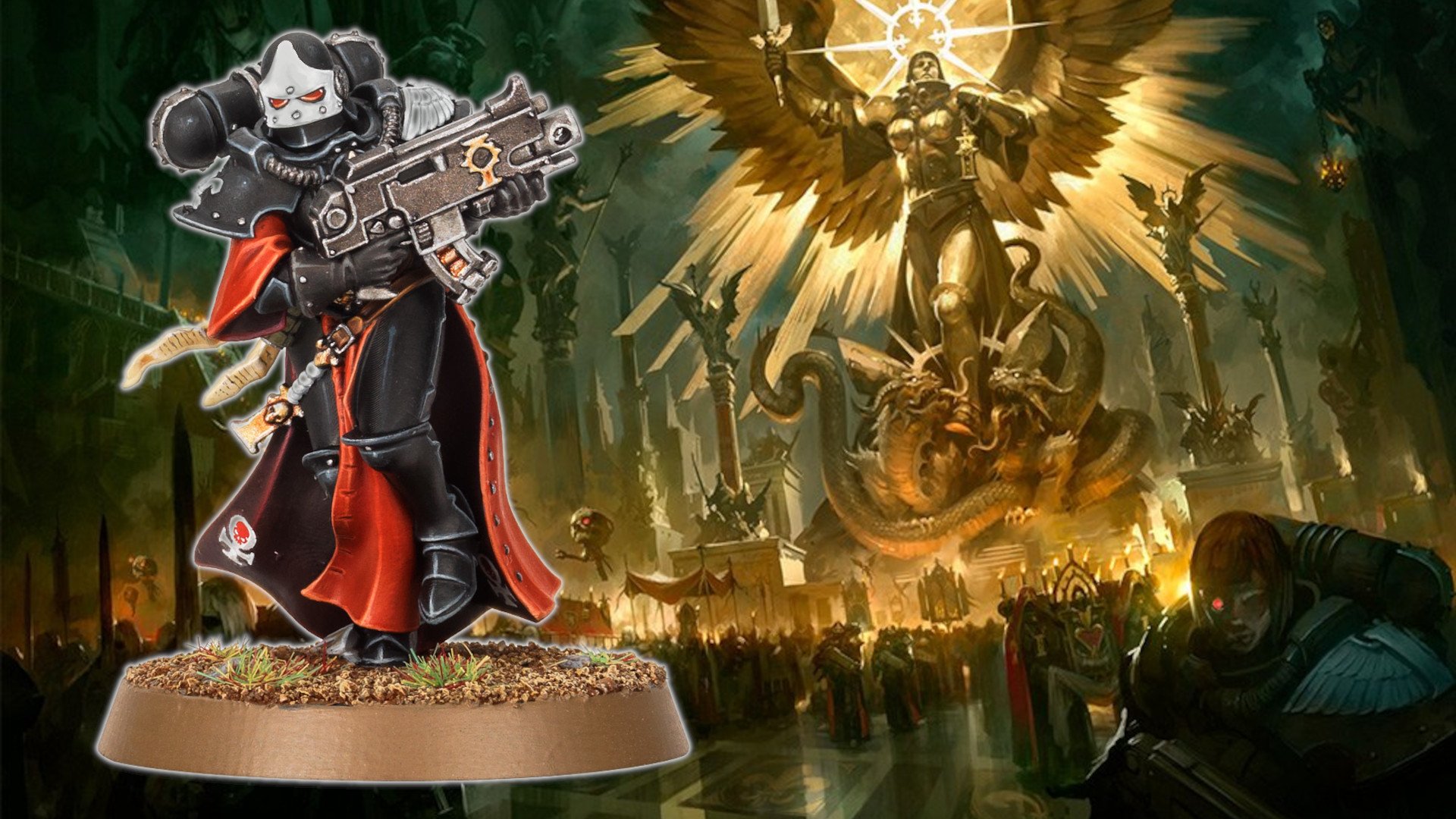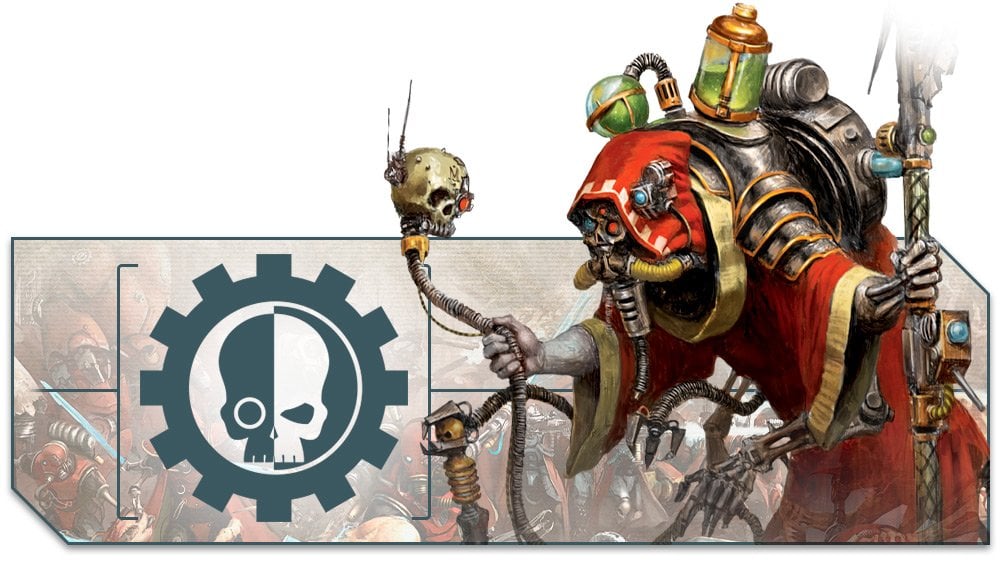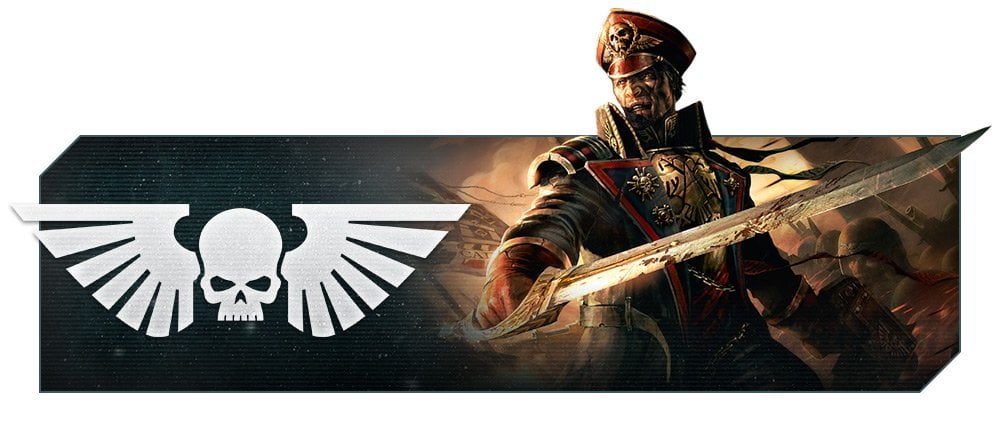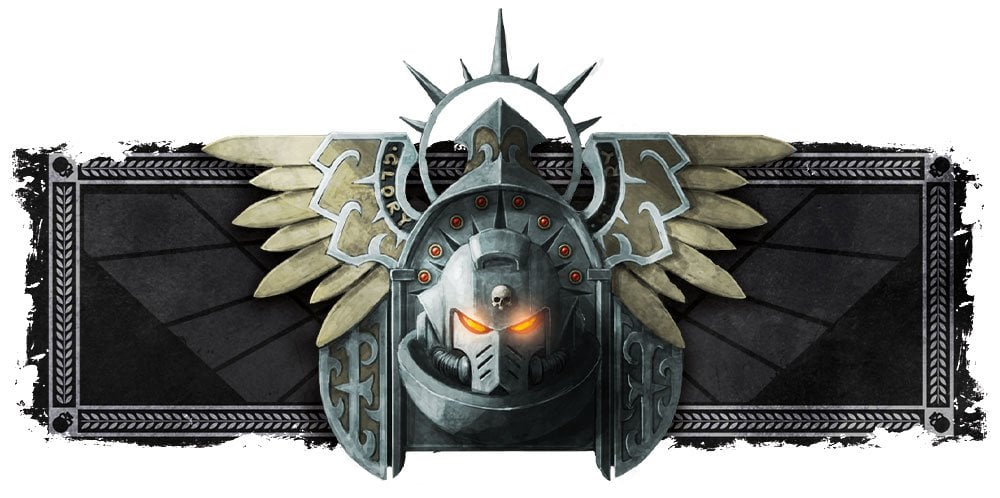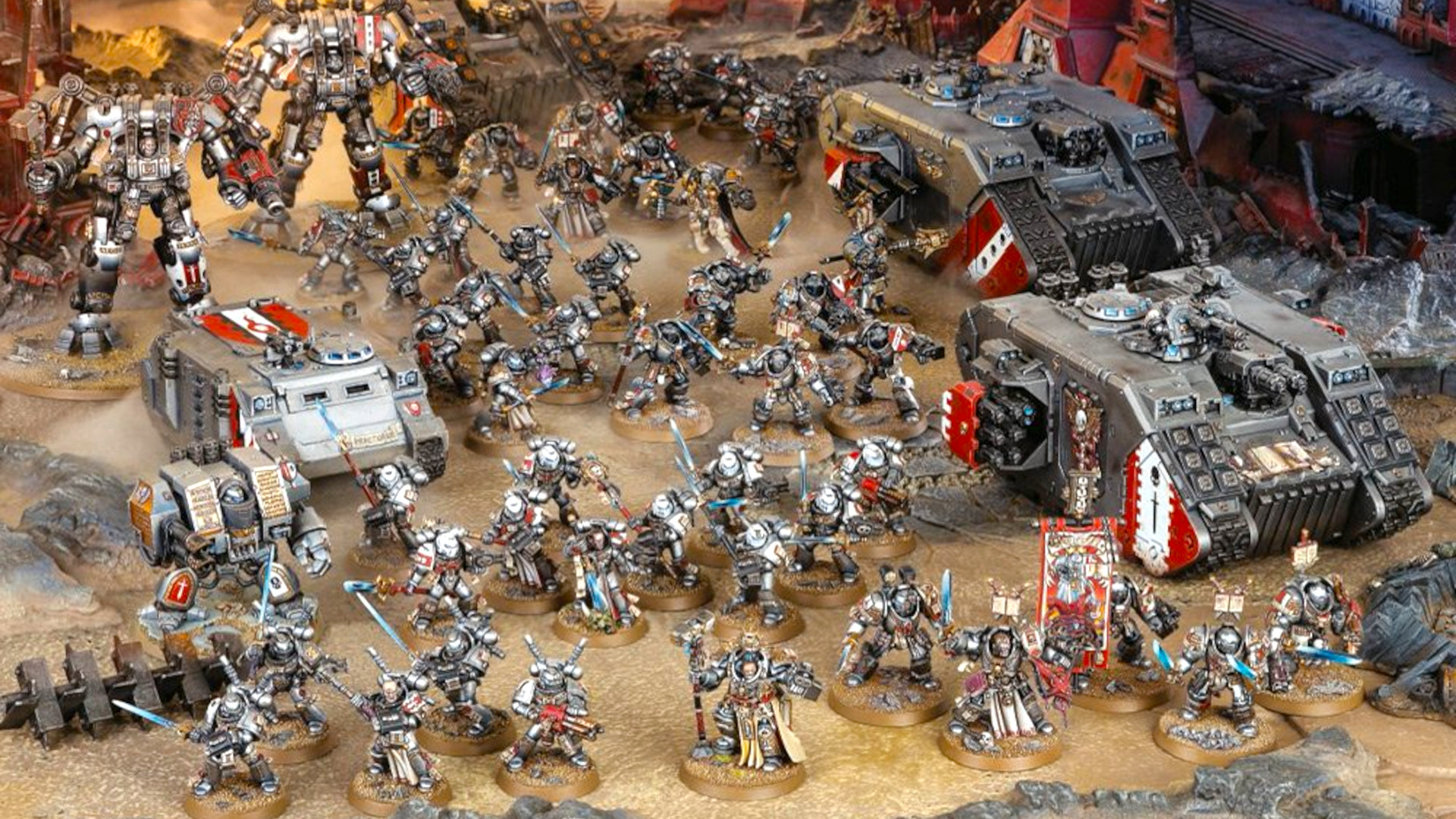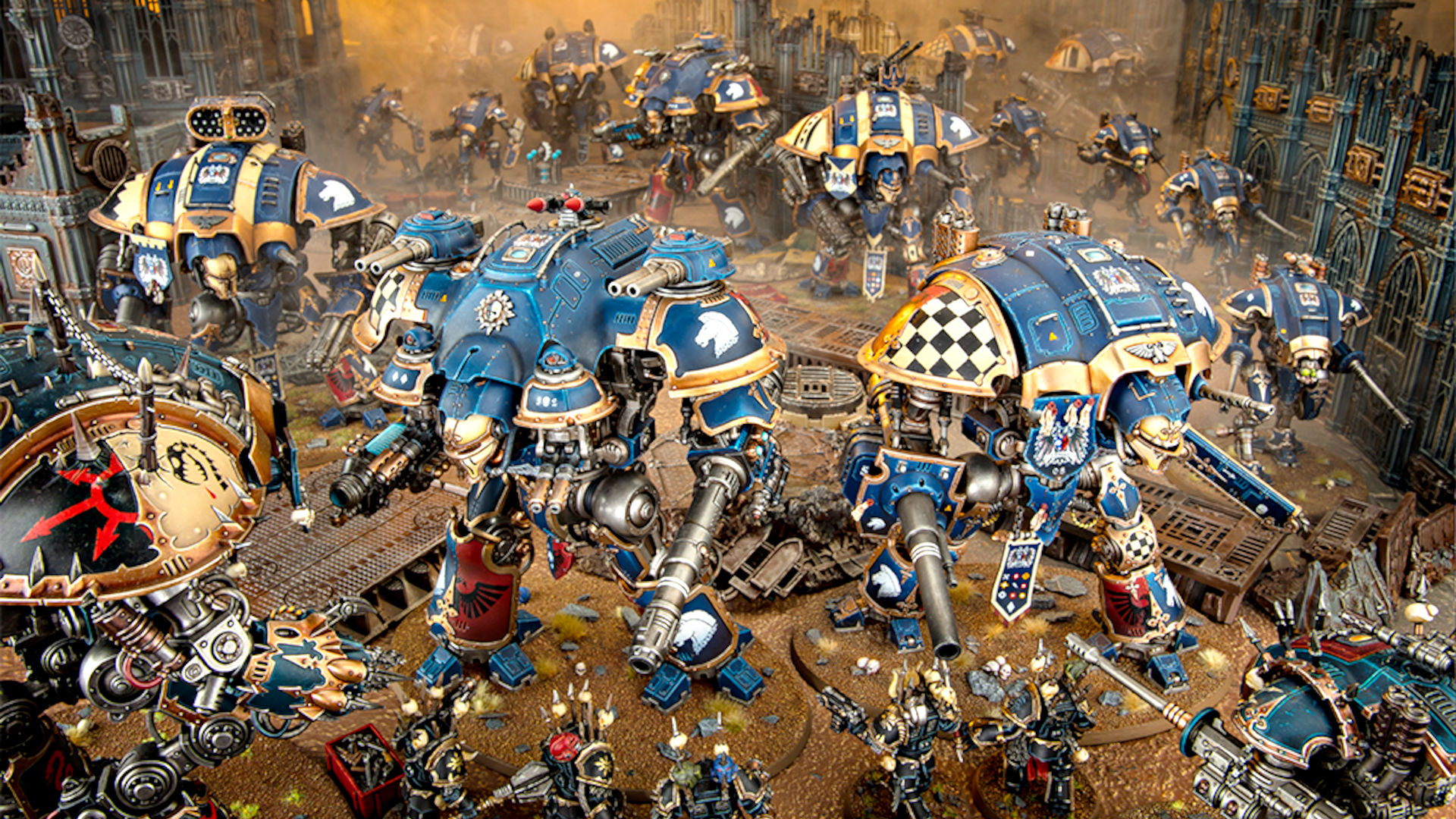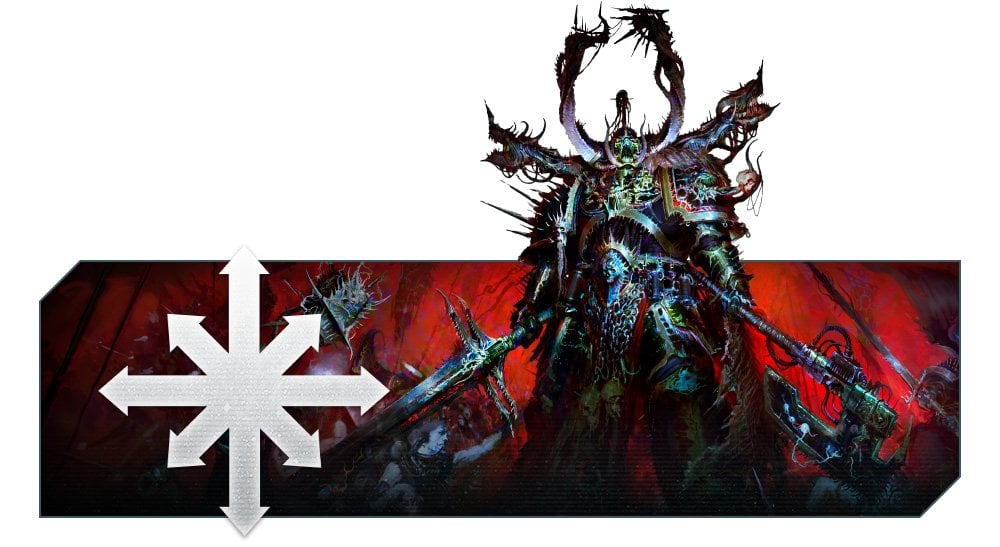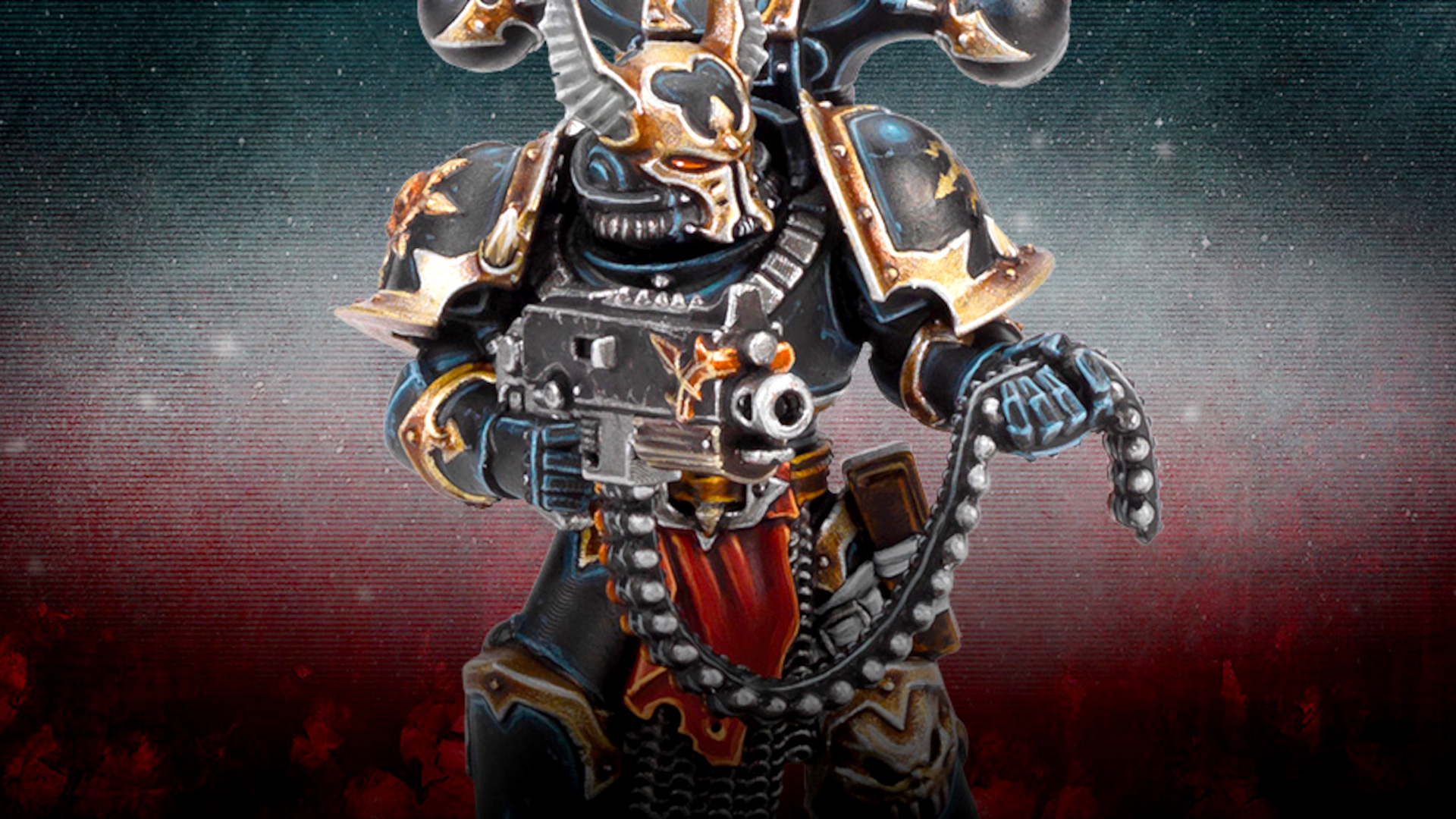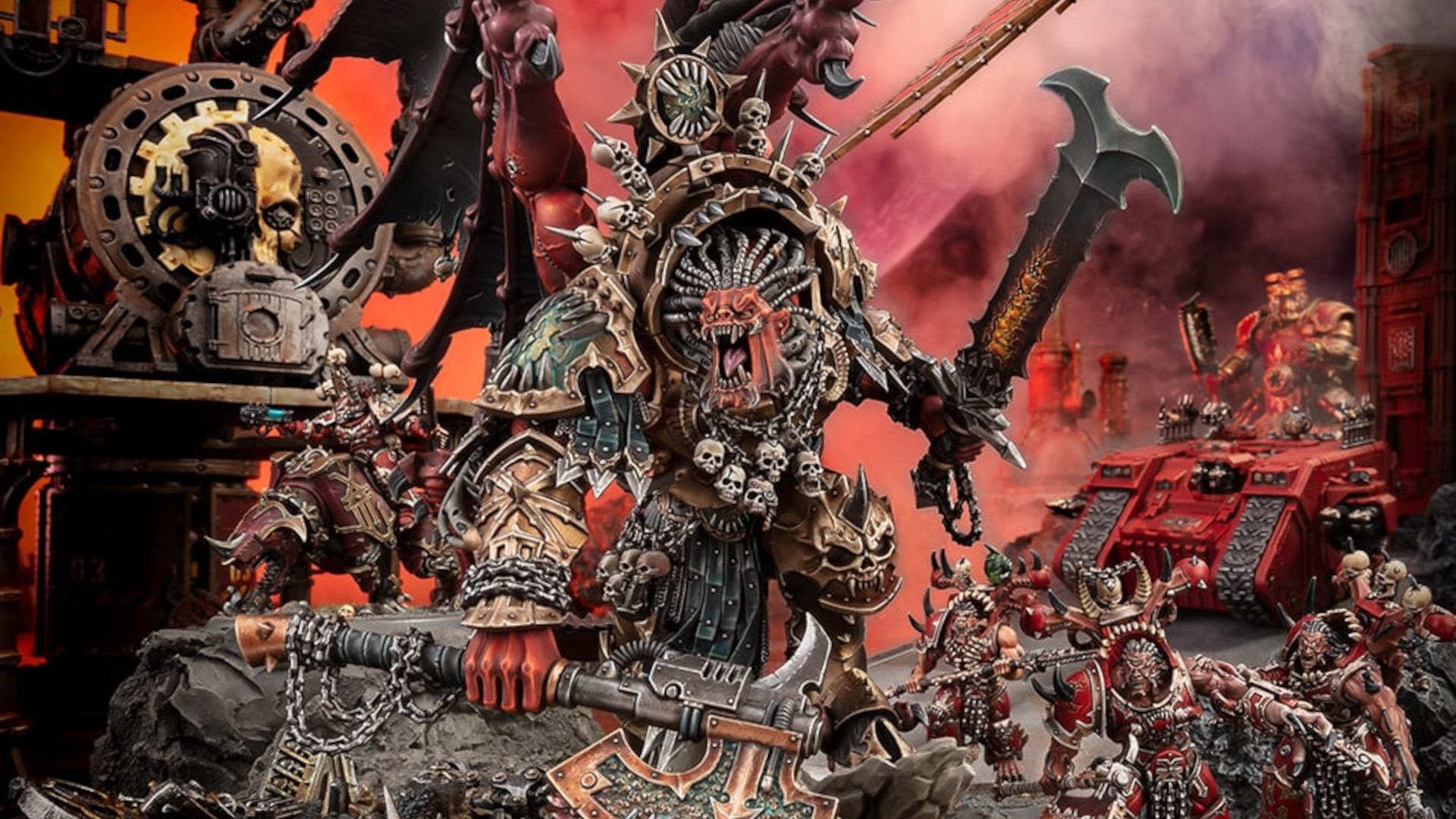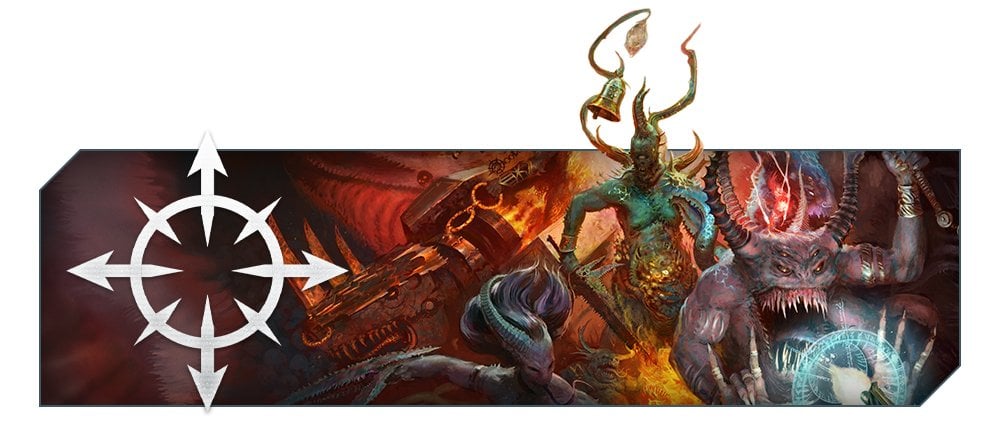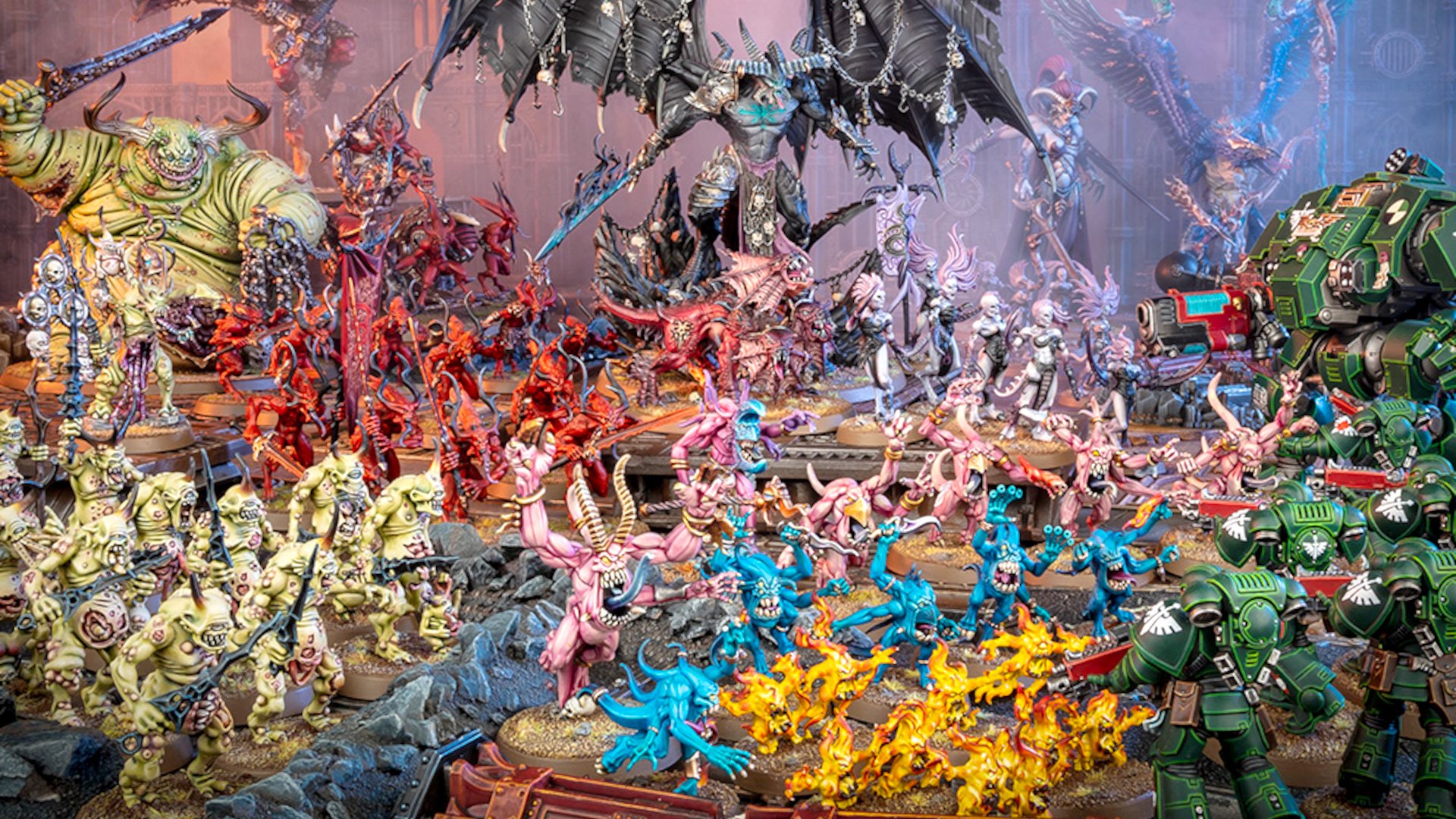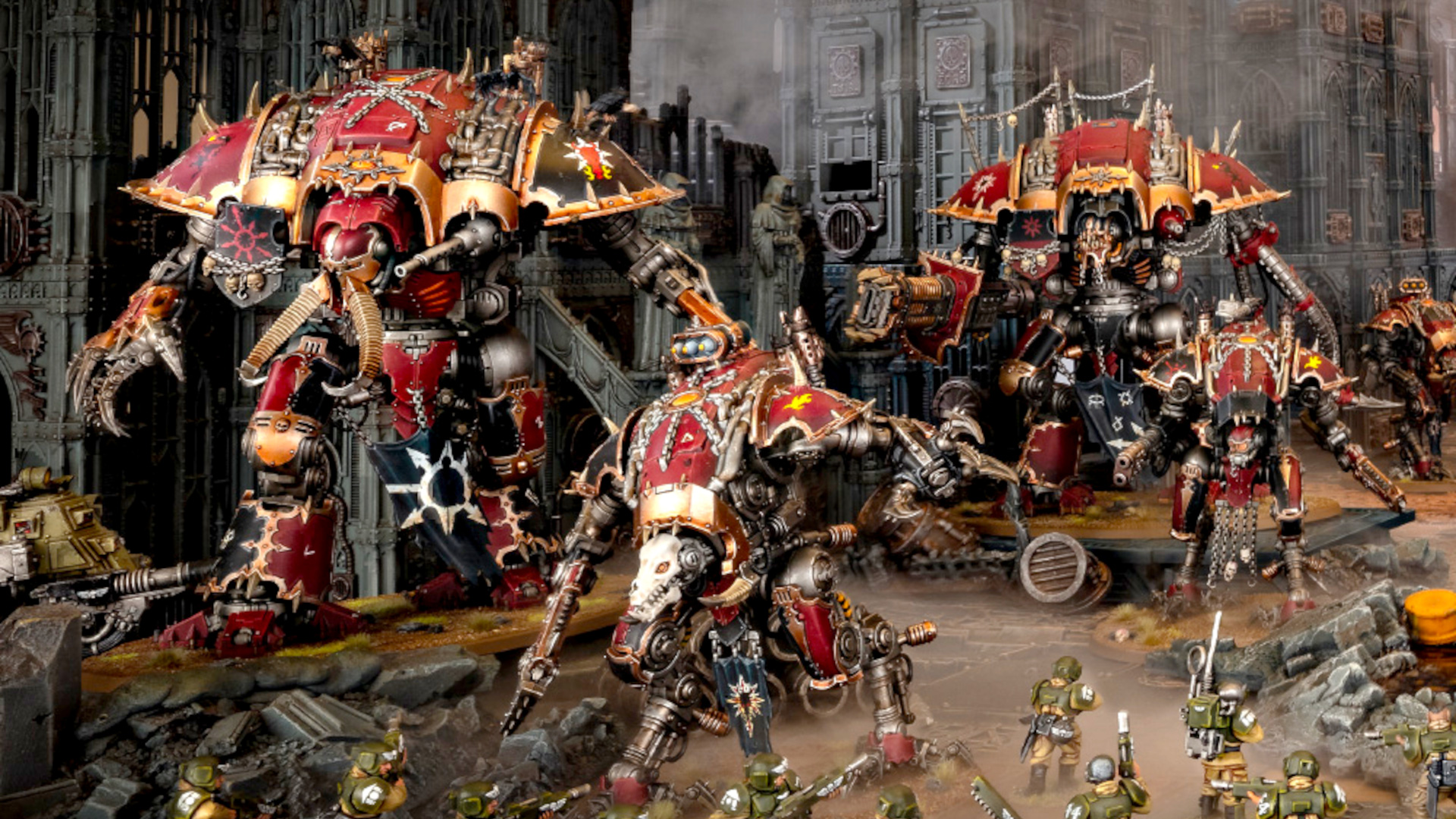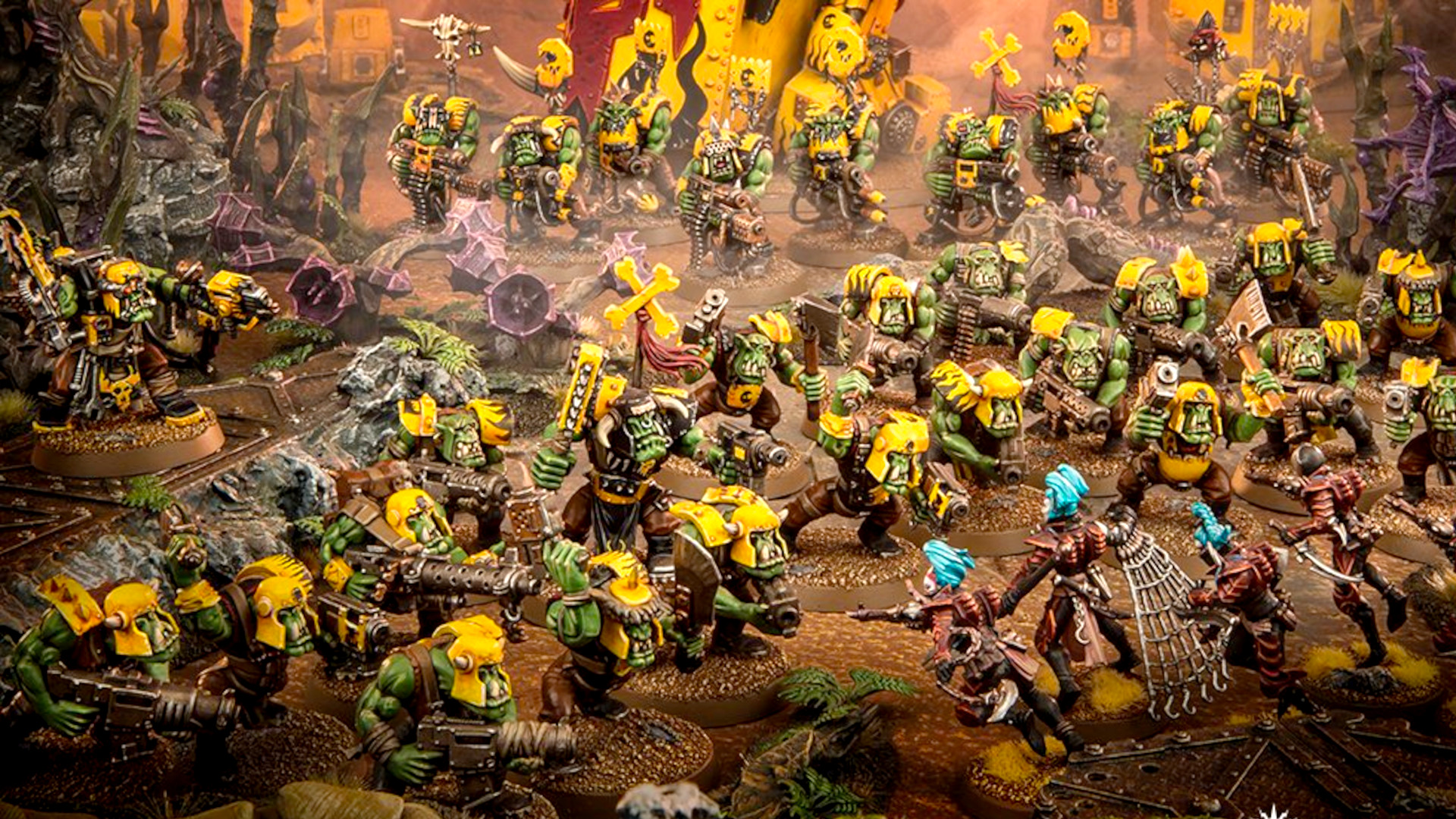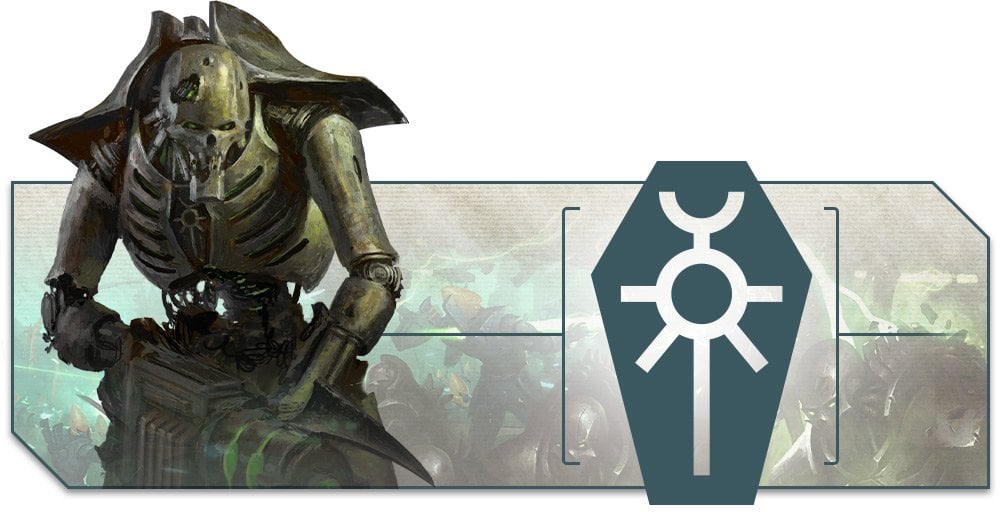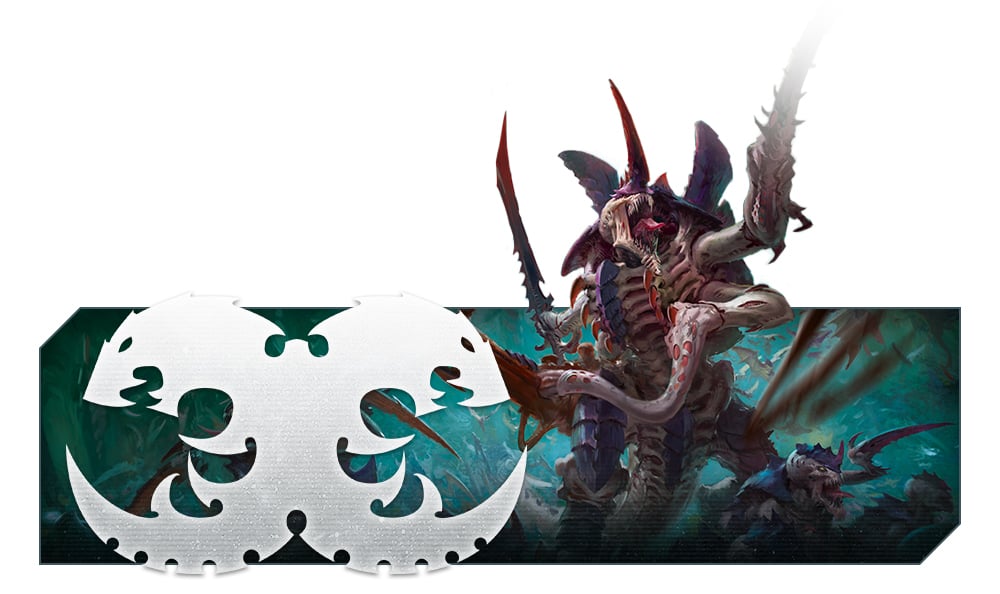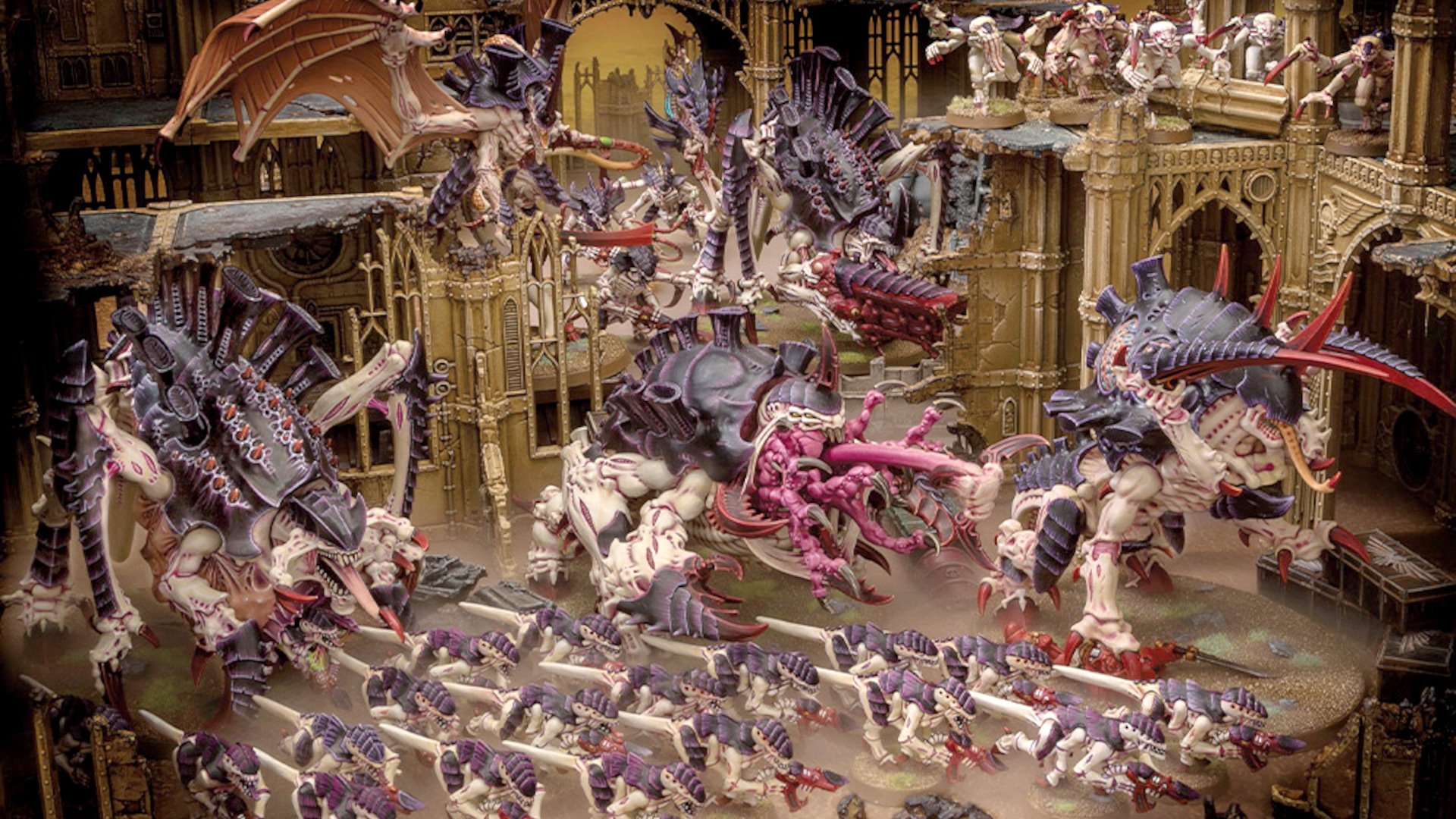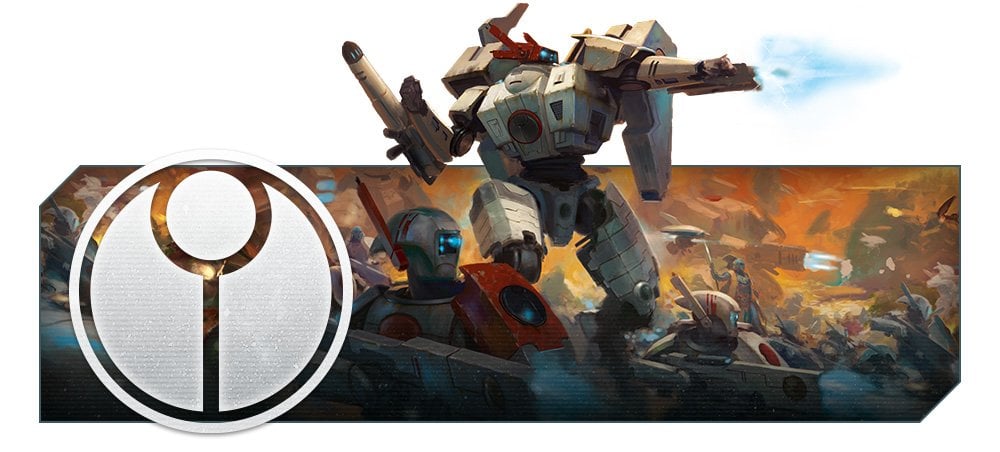To put things mildly, there are a lot of Warhammer 40k factions, races, and armies warring across the grimdark far future of Games Workshop’s flagship sci-fi wargame. 20 of them, in fact, and that’s only counting the ‘main’ 40k armies – the ones that get their own fully fledged codex rulebooks every edition.
There are at least another 13 offshoot factions (mostly specialised Space Marine chapters) with their own models and rules supplements, and depending on the edition of the game some or all of them get their own supplement rulebooks.
In this guide we’ll focus on the full-blown tabletop 40k armies to help you find the perfect one for you. We’ve also included some information on the minor factions who don’t get their own rules – click that link to skip to them.

Warhammer 40k super-factions
The many armies of the 41st millennium are roughly divided into three Warhammer 40k super-factions: the Imperium of Man, the Warhammer 40k Chaos factions, and the galaxy’s various species of aliens – known as the Warhammer 40k Xenos factions.
These umbrella categories are important in learning how to play Warhammer 40k, as (outside of narrative game modes) you’ll normally find Imperium armies can only team up with other Imperials; Chaos with Chaos; and most Xenos rarely make common cause with anyone. To dive deeper into each ‘super-faction’, click those links above to read our detailed guides for each.
If you want to jump straight into the game, check out our list of all the Warhammer 40k Combat Patrol starter sets, the perfect way to get started with Warhammer 40k 10th edition. If you want to know when your faction’s next rulebook is coming out, we’re keeping track in our Warhammer 40k Codex release date guide – but if you just want a brief overview of each of the galaxy’s fighting forces, read on.
Sisters of Battle
The Sisters of Battle (a.k.a. Adepta Sororitas) are the militant wing of the ‘Ecclesiarchy’ – the Imperium’s galaxy-wide state religion, fiercely worshipping the Emperor of Mankind on his Golden Throne on Terra (40k’s far-future earth).
Their lore origins are rather amusing: due to a diktat that the Imperial Faith wasn’t allowed to have its own force of ‘men under arms’, it instead raised an all-female army of bloodthirsty zealots, armed them all with deadly weapons and power-armoured corsets, and unleashed them on the Emperor’s enemies.
On the 10th edition Warhammer 40k tabletop, the Sisters of Battle are a powerful, but high skill-level force that relies on careful manoeuvring for victory – though that is aided by ‘Miracle Dice’ which allow you to store up useful dice results, and whip them out later in the game to get out of tight spots.
You can get a complete Adepta Sororitas lowdown in our full Sisters of Battle army guide.
Adeptus Custodes
The gold-armoured giants of the Adeptus Custodes are the personal bodyguard of the Emperor of Mankind – bigger, stronger, smarter, and deadlier than even the Space Marines, each one a masterwork of genetic alchemistry.
Originally there were 10,000 of them, but in the 41st millennium this elite force has been whittled down – though given their secretive nature, it’s hard to say just how many. Luckily, each individual ‘Custodian’ is a fighting force unequalled by almost any other being in the galaxy – meaning you’ll quite often see a tabletop army of Adeptus Custodes that’s just a handful of miniatures strong.
Don’t be fooled by the numbers, though. With the most powerful defensive wargear in the Imperium, it takes incredible firepower to take down a single Custodian, and if they’re able to get close, the Custodes’ exceptional offensive abilities and unique weaponry will tear through pretty much anything on the table.
Incidentally, they’re also the favoured army of everyone’s favourite famous fan of Warhammer 40k Henry Cavill – praise be!
To learn more about the Emperor’s golden boys, read our complete Adeptus Custodes army guide.
Adeptus Mechanicus
Originating on Mars and allied with the Imperium of Man, the Adeptus Mechanicus is a galaxy-spanning cult made up of technology-worshipping cyborgs, cybernetic ‘Servitor’ constructs, and legions of vast, ancient war machines (including the mighty Warhammer 40k Titans).
Led by a cadre of arcane Tech-priests (whose bodies are in various stages of conversion from flesh-sack to entirely synthetic metal and silicon avatar) the Adeptus Mechanicus maintains the Imperium’s galactic stocks of spaceships, tanks, aircraft, weapons, and armour. The AdMech’s own armies are made up of a mixture of cyborg Skitarii warriors, robotic battle automata, and high-tech war machines.
On the tabletop, AdMech armies tend to have an extra large helping of firepower, but their flesh-and-metal bodies (while no doubt very efficient) break easily under sustained fire or melee combat – so they’ll often want to shoot opponents off the board early. Those new to modelling and painting miniatures should also beware: these guys can be spindly and difficult to put together, with many nooks and crannies that are challenging to paint well.
For full details on the Imperium’s technological legions, check out our dedicated Adeptus Mechanicus army guide.
Or, if you want an excellent introduction to the lore and feel of the Adeptus Mechanicus, consider giving the videogame Warhammer 40k Mechanicus a play; it’s a fantastic game like XCOM in which a team of meddling Tech Priests go on a “research” expedition into a Necron tomb-world.
Astra Militarum
The Astra Militarum – also called Imperial Guard – is the Imperium’s standing army: a mind-bogglingly huge force of (mostly) human soldiers, tanks, and aircraft drawn from Imperial worlds all over the galaxy. They’re the first line of defence (and attack) in humanity’s never-ending war for survival and domination.
The Guard fight in gigantic formations of lightly-armed and -armoured infantry, massed artillery, and mass-produced tanks made as cheaply as possible from ancient blueprints nobody even understands any more. Wavering troops are kept in line by trigger-happy, Soviet-inspired ‘Commissars’ who, at critical points during games, can keep soldiers from running by shooting their own troops. Dark stuff.
On the tabletop, Guard armies customarily field bucketfuls of infantry squads, with company commanders expecting the vast majority to die before victory is achieved. Before that happens, though, there’s a lot of satisfying gameplay to be had in issuing various Orders to your units, setting them up for different tactical roles as you charge ahead. Remember, you can kill anything if you shoot enough lasguns at it.
To fully enlist in the Emperor’s human forces, dive into our complete Astra Militarum army guide.
Space Marines
The poster boys for both the Imperium and Warhammer 40k as a whole – you already know who the Space Marines are. Eight-foot-tall genetically enhanced super-soldiers, the Space Marines – a.k.a. Adeptus Astartes – march into battle in massive suits of power armour, adorned with the colours and heraldry of one of hundreds of proud ‘Chapters’.
The Emperor created the Space Marines over 10,000 years before the current 40k era, intending them to be his ultimate force to conquer the entire galaxy. That didn’t quite go to plan – the Horus Heresy civil war was something of a blip – but they’re now stronger than ever, reinforced with upgraded Primaris Space Marine variants, and they form the tip of the spear in all humanity’s wars, paving the way for the far more numerous Astra Militarum troops to land and do all the donkey work of conquest.
On the tabletop, Space Marines are generally known as the most accessible and forgiving faction to collect and play. Their rules are simple, they have lots of units to choose from, and they’re all relatively strong in both offensive and defensive roles.
Plus, with hundreds of unique Space Marine Chapters to choose from, it’s easy to create an army with the lore and looks you want. Space Marines have come in the Warhammer 40k starter set for every edition of the game, and it’s easy to see why.
To get all the rules to play Space Marines you’ll need their new Codex army book.
To properly induct yourself into the Adeptus Astartes, read our complete guide to Warhammer 40k Space Marines.
Grey Knights
The Grey Knights are a secret order of Space Marines based on Titan (Saturn’s largest moon) whose sole job is to hunt down and destroy the daemons of chaos. Specially selected as children from across the Imperium, every Grey Knight is a psyker, with a battery of psychic abilities for killing enemies, defending themselves, and banishing daemons back to hell.
In tabletop Warhammer 40k, the Grey Knights are a visually striking force of bluish-silver marines, garbed with knightly accoutrements, heraldry, and various cool-looking anti-daemon doodads.
Given their elite nature, you’ll be fighting with a smaller force than other armies – perhaps just a handful of Grey Knight Terminators and Paladins – but if you make clever use of their prodigious psychic abilities to keep your squads alive and make enemies dead, you’ll find them a deceptively deadly army.
If you want an excellent introduction to the lore and feel of the Grey Knights, consider giving Chaos Gate: Daemonhunters a play; it’s a fantastic game like XCOM in which your squad of extremely tough Grey Knights kick seven shades of snot out of the corrupt forces of Nurgle.
If you’re set on joining the psychic Knights of Titan, check out our in-depth Grey Knights army guide.
Imperial Knights
Towering, two-legged war machines piloted by a single, highly trained aristocrat, the Imperial Knights are technically the most elite fighting force in the galaxy – purely because hardly anyone knows how to make more of these ancient mechs.
Thudding into battle on massive metal legs, bedecked in preposterous amounts of chivalric heraldry, pennants, and emblems, the Imperial Knights are quite literally medieval knights, except riding 40-foot-high robot battlesuits instead of horses. Armed with weapons ranging from super-powered long range lasers to massive, upsized versions of Space Marine chainswords, knights are simultaneously super-cool, and too ridiculous for words.
Although each full-size Questoris Knight model will set you back at least $170 / £105, this is actually one of the cheaper Warhammer 40k factions to collect – because you only need about three models to make up a full army. With so few models to control, they’re also one of the most beginner-friendly forces – though be warned: building and painting these big fellas is a longer term commitment than almost any other Warhammer model.
Want to start a knightly house of your own? Indulge yourself with our complete guide to the Imperial Knights army.
Chaos Space Marines
Forming the main bulk of the forces of Chaos, the fearsome Chaos Space Marines are the dark, spiky mirror image of their Imperial counterparts. Long story short, 10,000 years ago, the Emperor’s favourite son Horus Lupercal struck a deal with mysterious dark gods to kill his dad, and took half the Space Marine legions with him in a rebellion that you can read all about in the massive Horus Heresy book series.
Horus lost, and died – but many of his traitorous Space Marines escaped, and have spent the last ten millennia rebuilding their power and numbers, and intermittently warring with the Imperials in the name of their chaos gods. They’ve also become more and more touched by the Warp powers they allied with, gaining daemonic comrades, as well as weapons, armour, and war machines imbued with unnatural powers.
On the tabletop, Chaos Space Marines are aggressive and temperamental, calling on the fickle powers of the warp with Dark Pacts that can imbue them with great power but may also disastrously backfire.
You’ll field core squads of Legionaries, backed up by Havoc gunners, jump pack-equipped Raptors, and swathes of human shields – er, Chaos Cultists, we mean. Not to mention daemon-possessed war machines. For the glory of the four in the Warp!
Ready to join the corrupt ranks of the Heretic Astartes? Check out our full Chaos Space Marines army guide for more info.
Death Guard
One of three standalone, specialised Chaos Space Marine armies, the Death Guard are a traitor Space Marine legion sworn to serve Nurgle, the chaos god of disease, decay, and entropy. During the Horus Heresy, the primarch Mortarion, lord of the Death Guard, made a desperate bargain for his legion’s survival – but in the process doomed them all to eternal servitude to the plaguefather.
In the 40k era, every last Death Guard Chaos Space Marine is a walking vector of the plague god’s disease, riddled with every infection imaginable and kept alive only by Nurgle’s otherworldly magic.
On the tabletop, endless tides of Plague Marines march into battle with inexorable plodding steps, backed up with a coterie of revolting but powerful character models to provide buffs; foul, corroded daemon engines; and crowds of diseased zombies charmingly called Poxwalkers. And let’s not forget their ever-present daemon pets, the cute, frolicking Nurglings.
Death Guard are slow, hardy, and spread a debilitating aura of plague across the battlefield that corrupts objectives and weakens their enemies.
If Mortarion’s diseased legions appeal to you, better get truly infected by reading our complete Death Guard army guide.
World Eaters
The World Eaters are the most recent Chaos Space Marine legion to receive their own, standalone army list. These fallen Space Marines are devoted to the Blood God Khorne, a deity with very simple tastes – blood and skulls, and it doesn’t matter where they come from. The World Eaters charge into the fray with murderous abandon, uncaring if they live or die; Khorne cares not from whence the blood flows.
It happens that the World Eaters Codex that released at the end of ninth edition was a stonker – simple, characterful, and extremely violent – and that brutal simplicity carries through to the tabletop in 10th edition.
Their signature unit is the Khorne Berserkers, frothing lunatics who exceed the might of ordinary Space Marines with the blessings of their god. They’re aided by almost-as-insane mortal cultists called Jakhals, and the considerably more unhinged Eightbound, each of whom is possessed by eight daemons.
The centrepiece of a World Eaters army is the daemon Primarch Angron. Unlike other centrepiece models, he has a passable chance of surviving the inevitable barrage of fire your opponent will send at him, because the World Eaters’ Blessings of Khorne rules allow them to resummon him after he gets shot to pieces.
Angron is also at the centre of the legion’s fall into ruin. A very brief summary is “extreme daddy issues” and “generational trauma by way of agonising brain surgery”.
Can’t resist your rage any longer? Rev your chainaxe and get stuck into our World Eaters army guide.
Thousand Sons
The sorcerous Thousand Sons were the first traitor Space Marine legion to receive an independent model range. Aligned with Tzeentch, chaos god of change, fate, and deception, the Thousand Sons are amongst the most powerful Warhammer 40k psykers – esoteric wizards driven by an insatiable desire for knowledge and deep understanding of the universe.
Though initially loyal to the Imperium, a series of tragic, well-intentioned mistakes by their primarch Magnus the Red during the Horus Heresy dragged the Thousand Sons into the clutches of chaos. Since then, they’ve pursued their own ineffable plots and quests across the galaxy, but always in opposition to the Emperor and his servants.
On the table, Thousand Sons armies centre on squads of Rubric Marines – empty suits of Space Marine power armour animated by chaos magic – supported by powerful chaos sorcerer marines, daemon engines, chaos animal-human mutants called Tzaangor, and – of course – daemons of Tzeentch.
Itching to be inducted into the mysteries of the Warp? Learn the sorcerous ropes with our full Thousand Sons army guide.
Chaos Daemons
Abominations spawned from the Warp (Warhammer 40k’s ever-present, terrifying parallel dimension) Chaos Daemons are a diverse horde of bizarrely-shaped, multi-coloured creatures that are technically just protrusions into our universe of the Warp’s ethereal forces. They’re entities formed by the will of the four chaos gods – Khorne, Nurgle, Tzeentch, and Slaanesh – with the objective of wreaking havoc in the real world.
Chaos Daemons can fight as allies to the Heretic Astartes or Chaos Knights, but they’re an army in their own right – with flexible rules that allow you to create forces allied to any one of the four gods, or a mixture of more than one. Each god commands a range of lesser daemons – small, large, fast, slow, some winged, some riding giant snails – and highly dangerous greater daemons like Nurgle’s Great Unclean Ones.
As befits this bewildering diversity, Chaos Daemons armies can function in all kinds of ways on the tabletop battlefield – but pretty much all rely on close-range combat to get their killing done; whether it be via Slaanesh’s impossibly fast Daemonettes, the furious melee attacks of Khorne Bloodletters, or Nurgle’s Plaguebearers and their infuriating unwillingness to take damage.
Check out our full Chaos Daemons guide to learn all the army’s most fearsome, cursed secrets.
Chaos Knights
Just as the Adeptus Astartes have their traitor counterparts, the Chaos Knights are the heretical mirror of Imperial Knights: these are the mech-warriors from the Knightly Houses who sided with the warmaster Horus Lupercal during the Horus Heresy, and never looked back (plus a few others who turned to chaos in the following ten thousand years).
Piloting largely the same type of walking war machine as the loyalists, and wielding similar weapons, the Chaos Knight models are set apart mainly by the Warp-touched details in their armour and equipment, and by their more sinister livery and decorations (think skulls, chains, and screaming faces replacing colourful flags and emblems). They have different unit names, too – with beast-faced War Dogs taking the place of Imperial Armiger-class knights, for example.
On the tabletop, Chaos Knights play similarly to the Imperials in many ways – but they’re less restrained and more aggressive. Their main unique mechanic is Harbingers of Dread, terrifying their foes and gives you bonuses that help you to snack on enemies as they succumb to battle-shock.
Want to command your own lance of fear-inducing hell robots? Get the full lowdown in our complete Chaos Knights army guide.
Orks
The Orks are an interesting contradiction of a Warhammer 40k faction: they are at once a truly scary, unstoppable force of pure, unfettered destruction – and the primary source of comic relief in an otherwise dour and serious sci-fi setting.
Massive, muscled, green aliens with huge teeth, axes, guns, and egos, the Orks are a race that lives exclusively to do three things: fight, fight, and reproduce (which they do primarily by fighting). The Orks take over planets by force, enslaving the populations to make more weapons for them (or just to eat). In the process they will seed the planet with their fungal spores, which grow into more Orks, which spread to more planets, and so on.
Orks don’t actually want anything, except more fighting, and – though they’re easily outsmarted or outmanoeuvred individually – they’re devastating in large numbers, and multiply incredibly quickly. As a result, they’re an implacable and almost invincible foe to the other races of the galaxy.
On the tabletop, Orks are one of the classic Warhammer 40k armies – an unstoppable green tide of lowly, axe-wielding Boyz, backed up by squadrons of ramshackle, scrap-built vehicles; crowds of impish little Grots; and, of course, mighty Warbosses (who lead their armies by dint of being bigger and stronger). Collecting and playing Orks takes time and commitment (you’ll have a LOT of Boyz to paint) but it’s an ever popular army, with much joy to be found in roaring “Waaagh!” across the table.
For all the info needed to become Big Boss of your own apocalyptic Green Tide, check out our complete Orks army guide.
Aeldari
The Aeldari (previously known as Eldar) are – let’s not beat around the bush – space elves. Tall and willowy; long-lived and wise; pointy-eared and full of poise; proud guardians of a once great but now withered empire – they are a direct sci-fi analogue of the Eldar in J.R.R. Tolkien’s Lord of the Rings.
That’s not to say they’re not a deep and compelling Warhammer 40k faction; the collapse of their erstwhile empire was so cataclysmic, it gave birth to the chaos god Slaanesh, and that’s just the tip of the Eldar lore iceberg.
In the 40k era, the Aeldari are splintered into various tribes, the largest being the Craftworld Eldar, who live on colossal, spacefaring civilisation-ships that house not only the living, but crystals holding the souls of all their dead. While their numbers are a tiny fraction of what they were, the Craftworld Aeldari can still field mighty warhosts, made up of both living warriors and war machines piloted by the sentient, crystal-bound souls of their ancestors.
On the tabletop, these warhosts fight very differently depending on their Craftworld – from the speed-obsessed Windrider Jetbikes of Saim-Hann to the powerful psychic Farseers and Warlocks of Ulthwé. Aeldari are slightly built and mostly lightly armoured, so your units will always be somewhat vulnerable – but they make up for it with powerful wargear and force-multiplying abilities. The Eldar were the most powerful faction in Warhammer 40k 10th edition when it launched, and a recent balance update has still left them pretty powerful.
Raising a noble Aeldari warhost of your own is a glorious undertaking – get all the guidance you need in our full Eldar army guide.
Drukhari
Depraved, sadistic raiders, slavers, and torturers, the Drukhari (previously known as Dark Eldar) fled the destruction of the ancient Aeldari empire, and, ironically, survived by building a culture based on the very dark perversions that brought the Eldar to ruin in the first place. They closely resemble their Aeldari cousins, but tend to wear darker, spikier clothes and armour, as befits their sinister nature.
Drukhari can only sustain their souls by directly feeding off the pain and suffering of others; they literally live by torturing people. As a result, they are a civilisation that runs on a steady diet of slaves, taken in constant piratical raids from anyone and everyone they can reach from their hidden city of Commorragh.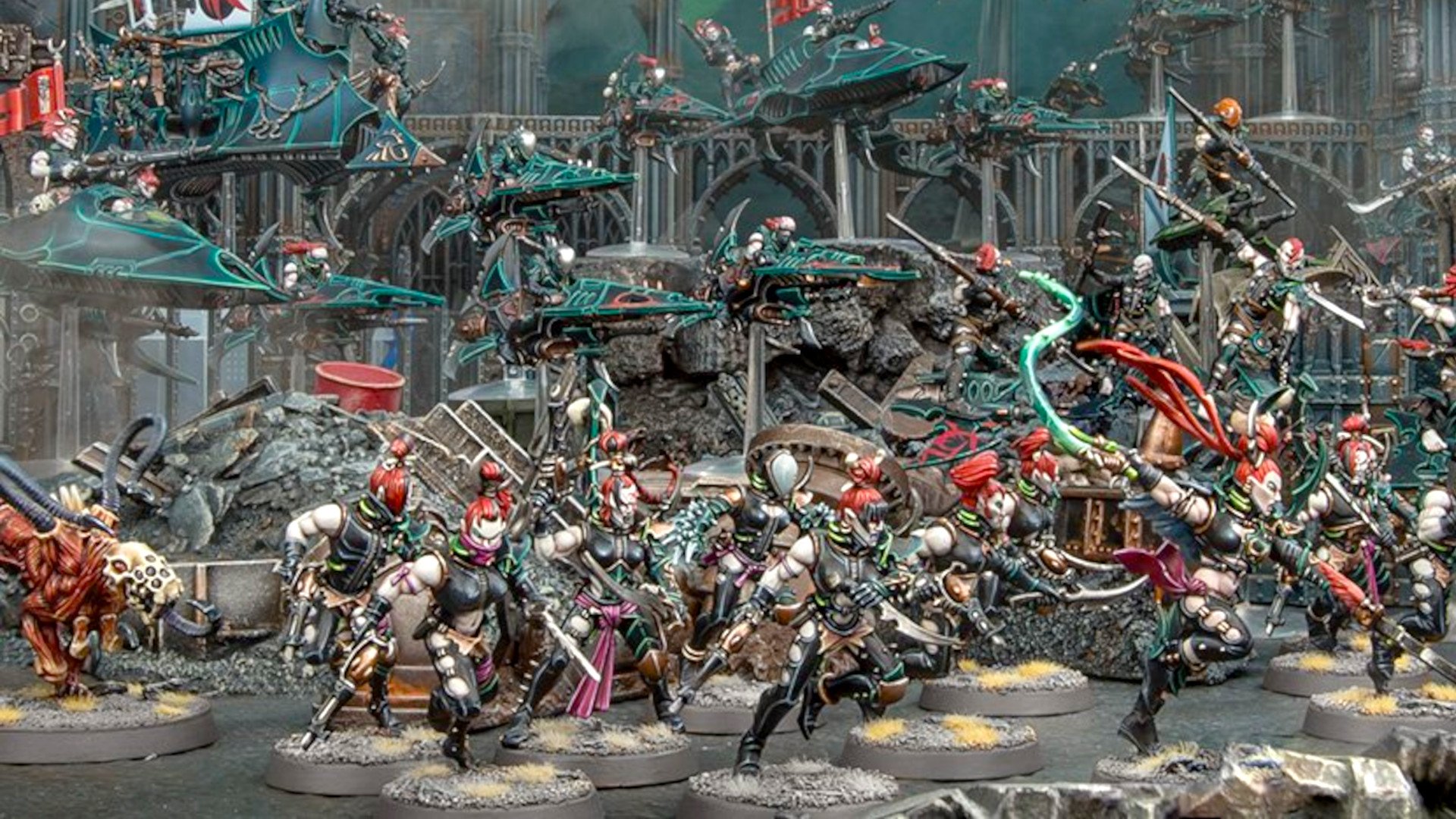
On the tabletop, the Drukhari are one of the fastest Warhammer 40k armies around, relying on their nippy flying gunboats to get right into the fight as soon as the game begins. Kabalite Warriors can fire freely from the open backs, while packs of drug-fuelled Wyches leap off to carve enemies up in close combat.
When necessary, these shock troops get backup from the horrific flesh-constructs of the Haemonculus Covens: patchwork warriors sewn together from bits of various unfortunate test subjects.
If you can’t wait to launch bloodthirsty raiding parties of your own, read our complete Drukhari army guide for more info.
Necrons
The ancient Egypt-inspired Necrons are technically both the oldest and most powerful of the Warhammer 40k factions. A race of cybernetic beings encased in immortal bodies of self-repairing living metal, their empire once spanned the entire galaxy. Getting to that point involved making some very bad deals with some very bad elder-entities known as the C’tan, which is how they came by their shiny metal bodies.
The C’tan didn’t mention the part of the “immortality” deal in which they would eat the Necron’s souls, so once the Necrons were finished pummelling all other galactic rivals, they went and blew up the C’tan. After that their entire civilisation went to have a nap in AI-controlled stasis crypts for about 60 million years.
Fast forward to the 40k era, the all-powerful Necron dynasties are waking back up, and they are awfully cranky about all the upstart races that have taken over all their territory.
Billions of soulless Necron warriors (along with their royal leaders and swathes of Canoptek machine servants) are reawakening from stasis all over the galaxy and taking back their old worlds by force. Most recently, Szarekh the Silent King, supreme ruler of all Necrons, has returned to lead them.
In games of Warhammer 40k, Necrons are a slow but resilient force, and, while most of their weapons have medium range, once they get up close they’ll blast most targets to atoms with little effort. Keep your royal Overlords protected, and make good use of the Reanimation Protocols rule to revive your lowly Necron Warriors whenever they fall, and your living metal legions will reliably frustrate and destroy your opponents.
Your legions awake; a thousand Tomb Worlds full of metal soldiers await your command – read our full Necrons army guide to get started.
Tyranids
The Tyranids are the great unknown among the Warhammer 40k factions – known as the Great Devourer, these scythe-limbed insectoid monsters only want one thing: to feast on every single living creature in the galaxy, until nothing remains. Encroaching from the great black beyond the galaxy’s edge, the Tyranid Hive Fleets are creeping further and further across it, consuming biomass and breeding as they go.
Made up of a huge diversity of different bio-forms, from swarms of tiny Rippers up to mountain-sized Hierophant Bio-Titans, Tyranids seed planets with their spore pods before raining down numberless hordes of warrior beasts to engulf, overwhelm, and devour whatever life called those places home. They cannot be negotiated with, and – so it seems – cannot be stopped, only slowed in their advance.
Tabletop Tyranids armies can be made up of just a few big monsters – but more usually you’ll see Tyranid players field larger hordes made from scores of deadly bugs, including swarms of organic gun-toting Termagants and razor-armed Hormagaunts, raving packs of four-armed Genestealers, and hulking Tyranid Warriors. Their one weakness? Tyranids rely on their Hive Mind – and its Synapse links – for their greatest strengths; separate the swarm from its leaders, and the rest of the bugs are much easier to squash.
Tyranids were the recipients of the first Codex army book for Warhammer 40k 10th edition, which you’ll need if you want to get access to all their rules.
Want to consume the entire galaxy at the head of a murderous Hive Fleet of your own? Read our complete Tyranids army guide to find out how.
T’au Empire
The T’au Empire is a growing conglomerate of alien species united by an idealistic vision of galactic expansion through diplomacy. One of the youngest Warhammer 40k races, the slender, blue-skinned T’au – led by their rigid ruling caste of Ethereals – are unusual, in that they don’t always default to achieving their goals through warfare.
That said, the Empire’s ethos of peaceful expansionism is always backed up by the threat of war, made manifest in its warlike fire caste and their armory of devastating, high-tech guns. If a world doesn’t want to join the T’au’s utopian project freely, it will usually be persuaded otherwise with overwhelming force.
What the T’au lack in numbers and territory, they more than make up for in martial skill and superior weapons tech; a small force of pulse rifle-armed T’au Fire Warriors, advanced Crisis Battlesuits, and Stealth-suit infiltration squads can often outgun far larger opponents with ease.
On the Warhammer 40k tabletop, T’au armies have traditionally been a static gun line – you mass your troops in a defensive position, sit back, and shoot your long-range weapons at the enemy until either you win, or they close with your lines and you’re cut into little blue pieces. They’re more dynamic in the latest edition, so if you like flexible strategy, high-tech mech suits, big guns, and anime, this is the 40k faction for you.
Check out our dedicated guide to the Tau Empire to continue the fight for the Greater Good, with way more lore details and up-to-date rules analysis.
Genestealer Cults
One of the newest Warhammer 40k factions on the tabletop (though they’ve been part of the lore since the start), the Genestealer Cults are an army of genetic bodysnatchers, insidious outriders of the Tyranid Hive Fleets. Most members of this faction look like normal humans – workers, miners, farmers, guards – but are in fact alien hybrids, slowly infecting the population on behalf of their unseen Tyranid masters.
Tyranid Genestealers sneak onto inhabited planets and implant their DNA into living subjects. When these infected individuals reproduce, they’ll give rise to Genestealer hybrids. Once enough people have been converted, they form underground cults that worship the ‘star children’ and begin to foment unrest and destabilise the planet – softening it up for the coming Tyranid invasion.
As a tabletop Warhammer 40k army, Genestealer Cults are a relentless horde: when their units die there’s a very good chance that they’ll return to play, creeping up behind your enemy after they’ve incautiously advanced towards your lines.
In keeping with their theme of being a covert force embedded as ordinary workers, the Cults’ basic troops are lightly armed and armoured, not much threat on their own. Those who are in the more Genestealer-y stages of mutation can pose more of a threat, however – and fully transformed Purestrain Genestealers are just as deadly as their full-on Tyranid cousins.
With the launch of Warhammer 40k 10th edition the Genestealer Cults were one of the most powerful factions out there – though a balance dataslate has taken away some of their most powerful abilities.
Raise the flag of revolution and claim whole planets in the Star Children’s name with our complete Genestealer Cults army guide.
Leagues of Votann
The newest Warhammer 40k faction – released by Games Workshop in September 2022 – the Leagues of Votann are a reimagining of the original Squats (space dwarfs) from the game’s first edition in 1987.
Given a heavy dose of grimdark seriousness to dilute the original Squats’ beardy silliness, these stout, sour-tempered warriors are highly dangerous, packing some of the galaxy’s deadliest weapons. So powerful were they, in fact, that GW nerfed the faction before it had even properly released – in the latest edition of the game they’re a lot more tame.
The Leagues of Votann – who call themselves ‘The Kin’ – live in the perilous galactic core region, routinely avoided by the other 40k races due to its many dangers to ships passing through. A clone race, they closely guard the technological secrets of their survival, and – though they did originally come from Terra – have no love for humanity or its Imperium.
They mainly spend their time mining stars and planets for rare ore, and trading with other races whenever they can see profit in it. Though not inherently warlike, the Kin see any valuable territory or materials as rightfully theirs for the taking, and don’t hesitate to blast anyone who’ll stand between them and a profitable mining prospect. True space dwarfs indeed.
Votann have some of the best technology available to the (post) human species. Their Hearthkyn warriors and turtle-shelled Einhyr Hearthguard elites can flex into various roles thanks to a good choice of potent guns; and they’ve got very solid vehicles to ferry troops around, providing withering heavy weapons fire.
The Eye of the Ancestors rule reflects their cantankerous nature – when an enemy unit destroys one of your units, it gets easier for your entire force to hit and to wound that enemy. They took a bit of a battering at the start of 10th edition 40k, becoming one of the game’s weaker armies, but a balance update in September 2023 gave them some fairly substantial buffs.
For full details on the Kin and their galaxy-beating armoury, check out our complete Leagues of Votann army guide.

Minor Warhammer 40k factions
While those above are the main, distinctive, playable tabletop armies in Warhammer 40k, there are countless other minor Warhammer 40k factions, sub-factions, and looser groupings referred to in game rules, Warhammer 40k books, and across the setting – we’ll briefly explain just the most relevant ones here.
Agents of the Imperium
In Warhammer 40k 10th edition, Agents of the Imperium is a blanket term for a large variety of Imperium miniatures that people own, love, and want to play with, but don’t fit directly into one of the main tabletop armies.
The main in-game purpose for this umbrella term is to provide organized rules to let you “ally in” these specialist warriors as part of another Imperium army list, without suffering the rules disadvantages that would normally cause.
Minor imperial factions that get main-line Warhammer 40k game rules this way include:
- The Inquisition
- Officio Assassinorum
- Adeptus Arbites
The Inquisition
The Inquisition is a functionally independent and all-powerful branch of the Imperial government – basically a universally feared secret police that sits above the law – whose job is to fight ‘unorthodox’ enemies outside and inside humanity’s borders.
The Inquisition is split into several different “holy Ordos” – including the Ordo Malleus, specializing in daemon hunting, and the Ordo Xenos, experts at dealing with alien threats. All are incredibly powerful, and all can command some of the most esoteric and dangerous weaponry in the galaxy.
For complete details, read our unredacted Warhammer 40k Inquisition guide.

Officio Assassinorum
The Emperor’s own sanctioned, official assassins, the elite ‘temples’ of the Officio Assassinorum train deadly, specialized killers and send them out to efficiently destroy specific individuals that the Imperial government would prefer to disappear.
There are many flavors: Vindicare assassins excel at long-range sniper shots; Callidus assassins move and cut throats with impossible speed, stealth, and acrobatics; Culexus assassins are perfectly adapted to turn the powers of Psykers against them, and so on.
In tabletop armies, one or two of these vulnerable, but highly powerful characters can add huge strategic value to your side.
For more info, read our full guide to Warhammer 40k assassins.

Adeptus Arbites
The Adeptus Arbites is the Imperium’s galaxy-wide, paramilitary police force, responsible for enforcing law and order among the citizenry with an iron fist and a big shotgun. Arbites officers look, sound, and act exactly like Judge Dredd, and that is in no way an accident.
The Arbites got official tabletop models for the first time in the February 2023 Soulshackle box set for Warhammer 40k Kill Team – but you can get the Arbites Exaction squad minis separately now, and use them in full 40k games using the Agents of the Imperium rules.

Collegia Titanica
The Collegia Titanica is an incredibly ancient sub-faction of the Adeptus Mechanicus, whose role is to maintain and pilot Warhammer 40k Titans in war – colossal walking war machines that can level cities in moments.
In tabletop Warhammer 40k, titans are the size of toddlers, extremely expensive Forge World resin models that are very rarely seen on the tabletop – partly for those reasons, and partly because, for rules purposes, each one costs roughly twice the points of a normal full army.
Asuryani
Asuryani (pronounced ahh-suh-ree-yah-nee) is a cultural shorthand for the Craftworld-dwelling Aeldari – as distinguished from the mysterious Harlequins, the outcasts and corsairs, and their twisted Drukhari cousins.
The name comes from the Phoenix King Asuryan, father and chief of the Aeldari gods, and brother to Kaela Mensha Khaine, the Eldar god of war.
Harlequins
Harlequins are one of the weirdest minor 40k factions: a very small, very secretive sect of mystical Aeldari warrior-performers who worship the Eldar deity Cegorach – the Laughing God. Their sacred task is to protect the Black Library, an ancient repository of Eldar history, knowledge, science, and dark secrets hidden deep within the interdimensional Webway.
In battle, Harlequins wear extravagant, vibrantly colored and patterned costumes, and strange, grinning masks. They fight with supernatural grace, speed, and surety, with lightning reflexes and acrobatic maneuvers key to a Harlequin victory – after all, wearing no armor gets you killed unless you’re a real smooth mover.
In tabletop Warhammer 40k, the Harlequins have functioned differently at different times – sometimes with their own full codex; sometimes as a sub-faction of the main Aeldari rule set. In 10th Edition, Harlequins have been fully rolled into the main Aeldari index army list, though that may change when the full 10th Edition Aeldari codex details are published.

Ynnari
The Ynnari are a slightly confusing crossover sub-faction of the different Eldar armies – a revolutionary religious and political force that counts Craftworld Aeldari, Drukhari, and Harlequins among its adherents and warriors.
The name comes from Ynnead – the Aeldari god of the dead – whom the Ynnari believe they can reawaken in the material universe, in order to defeat the Chaos god Slaanesh and release his/her/their historic claim upon the souls of the Eldar species.
At the close of 7th Edition and dawn of 8th Edition Warhammer 40k, in 2017, the actions of the Ynnari and their leaders – Yvraine, the Visarch, and the Yncarne – were central to the main narrative storyline, although their importance has waned significantly since, with the ongoing relevance and activity of the Ynnari shrouded in some mystery.
Dark Mechanicum
The Dark Mechanicum is to the Adeptus Mechanicus, as the Chaos Space Marines are to the Space Marines, or the Chaos Knights to the Imperial Knights. It’s the name given to AdMech tech-priests, war machines, Skitarii, and even titans who have abandoned the Imperium and the Omnissiah and thrown their lot in with Chaos.
During the Horus Heresy, a huge part of the Mechanicum pledged itself to Horus Lupercal, entranced by the possibilities of infusing their material technologies with the immeasurable, unpredictable twisting powers of the Warp. The result was ‘hereteks’ – corrupted Mechanicum tech priests, adept at creating terrifying warp-addled war machines and daemon engines.
While the Dark Mechanicum doesn’t yet have its own dedicated model range, it has been increasingly wished for among the warhammer community over recent years, and many fans are convinced it can’t be long before we see them realized as official tabletop miniatures.
Want to get a feel for Warhammer 40k armies but don’t fancy reading more lore? Check out our guides to the best Warhammer 40k games on PC and console, and the best Warhammer 40k books that can introduce you to the setting through thrilling stories and action.
